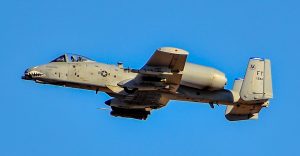1972.After almost ten years of development a new aircraft took off for the first time. Four years later it entered service with the US Air Force and the USMC. Since then, every soldier who fought in any branch of the us military force learnt to recognize the whistling sound of its engines, the beauty of its shape and, above all, the buzzing sound of its main gun. I’m talking about the Fairchild Republic A 10 thunderbolt II, more simply called the Warthog.
 This aircraft has a long history and it is considered by many the best CAS (close air support) aircraft ever produced. This year, however, this legend could see the end of its career due to the age of its airframe. Even if the congress wants to keep it flying to reduce the costs of the probable development of its needed successor, the US Air Force itself is reluctant on that point.
This aircraft has a long history and it is considered by many the best CAS (close air support) aircraft ever produced. This year, however, this legend could see the end of its career due to the age of its airframe. Even if the congress wants to keep it flying to reduce the costs of the probable development of its needed successor, the US Air Force itself is reluctant on that point.
Currently there are 103 million dollars of budget to complete the urgent replacement of the wings on the fleet of A 10 in use, but this will probably never happen. As Todd Mathes, an officer of the Air Force, told us: ”Spending so much money on an old aircraft is no longer worthy for the congress nor for the taxpayers”.
Their plan is to leave the already upgraded aircrafts (about 171) in use for at least five years and retire all the others (about 130), bringing the number of squadrons from 9 to 6. Although this is the official path chosen by the US Air Force, someone disagree. According to captain Martha McSally, a former A10 pilot and squadron commander, 6 squadrons would not be enough to meet the needs of the troops in the field. It has to be said that, despite the Warthog has proven itself to be the most effective and most in demand aircraft to protect ground troops in Afghanistan and Iraq, the Air Force had repeatedly attempted to shrink or cancel the A 10 program.
In 2007, for instance, Boeing won the contract to build new wings and other parts of the airframe. Air Force leadership, however, allowed this contract to lapse in 2016, this resulting in an extra cost of about 103 million dollars to restart the wings production line.
Nowadays, without new wings, the Air Force is able to force the hand of the congress and retire the older aircrafts claiming it had no choice as a result of metal fatigue.
Whatever will be the future of this mighty aircraft it will always be remembered from the ones who fought with its shadow in the sky, knowing that it means an extra chance to return home alive.
Matteo Bramati, 5 B Tecnico



